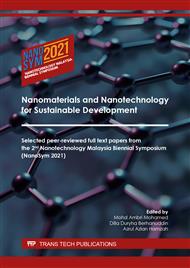[1]
S. Datta, T. Ashley, J. Brask, L. Buckle, M. Doczy, M. Emeny, D. Hayes, K. Hilton, R. Jefferies, T. Martin, T.J. Phillips, D. Wallis, P. Wilding, R. Chau, 85nm gate length enhancement and depletion mode InSb quantum well transistors for ultra high speed and very low power digital logic applications, Tech. Dig. - Int. Electron Devices Meet. IEDM. (2005) 763-766.
DOI: 10.1109/iedm.2005.1609466
Google Scholar
[2]
H.A. Nilsson, P. Caroff, C. Thelander, E. Lind, O. Karlström, L.E. Wernersson, Temperature dependent properties of InSb and InAs nanowire field-effect transistors, Appl. Phys. Lett. 96 (2010) p.153505.
DOI: 10.1063/1.3402760
Google Scholar
[3]
E. Memisevic, M. Hellenbrand, E. Lind, A.R. Persson, S. Sant, A. Schenk, J. Svensson, R. Wallenberg, L.E. Wernersson, Individual Defects in InAs/InGaAsSb/GaSb Nanowire Tunnel Field-Effect Transistors Operating below 60 mV/decade, Nano Lett. 17 (2017) 4373-4380.
DOI: 10.1021/acs.nanolett.7b01455
Google Scholar
[4]
T. Vasen, P. Ramvall, A. Afzalian, G. Doornbos, M. Holland, C. Thelander, K.A. Dick, L.E. Wernersson, M. Passlack, Vertical Gate-All-Around Nanowire GaSb-InAs Core-Shell n-Type Tunnel FETs, Sci. Rep. 9 (2019) 1-9.
DOI: 10.1038/s41598-018-36549-z
Google Scholar
[5]
S. Breuer, C. Pfüller, T. Flissikowski, O. Brandt, H.T. Grahn, L. Geelhaar, H. Riechert, Suitability of Au- and self-assisted GaAs nanowires for optoelectronic applications, Nano Lett. 11 (2011) 1276–1279.
DOI: 10.1021/nl104316t
Google Scholar
[6]
J.E. Allen, E.R. Hemesath, D.E. Perea, J.L. Lensch-Falk, Z.Y. Li, F. Yin, M.H. Gass, P. Wang, A.L. Bleloch, R.E. Palmer, L.J. Lauhon, High-resolution detection of Au catalyst atoms in Si nanowires, Nat. Nanotechnol. 3 (2008) 168–173.
DOI: 10.1038/nnano.2008.5
Google Scholar
[7]
D. Anandan, R.K. Kakkerla, H.W. Yu, H.L. Ko, V. Nagarajan, S.K. Singh, C.T. Lee, E.Y. Chang, Growth of foreign-catalyst-free vertical InAs/InSb heterostructure nanowires on Si (1 1 1) substrate by MOCVD, J. Cryst. Growth. 506 (2019) 45–54.
DOI: 10.1016/j.jcrysgro.2018.09.046
Google Scholar
[8]
D. Anandan, V. Nagarajan, R.K. Kakkerla, H.W. Yu, H.L. Ko, S.K. Singh, C.T. Lee, E.Y. Chang, Crystal phase control in self-catalyzed InSb nanowires using basic growth parameter V/III ratio, J. Cryst. Growth. 522 (2019) 30-36.
DOI: 10.1016/j.jcrysgro.2019.06.016
Google Scholar
[9]
R.K. Kakkerla, C.-J. Hsiao, D. Anandan, S.K. Singh, E.Y. Chang, Growth and crystal structure investigation of self-catalyst InAs/GaSb heterostructure nanowires on Si substrate, in: 2017 IEEE 12th Nanotechnol. Mater. Devices Conf. NMDC, (2017), 133-134.
DOI: 10.1109/nmdc.2017.8350531
Google Scholar
[10]
M.B. Borg, L.E. Wernersson, Synthesis and properties of antimonide nanowires, Nanotechnology. 24 (2013) 202001-202018.
DOI: 10.1088/0957-4484/24/20/202001
Google Scholar
[11]
S.G. Ghalamestani, S. Lehmann, K.A. Dick, Can antimonide-based nanowires form wurtzite crystal structure?, Nanoscale. 8 (2016) 2778–2786.
DOI: 10.1039/c5nr07362f
Google Scholar
[12]
K.L. Kavanagh, Misfit dislocations in nanowire heterostructures, Semicond. Sci. Technol. 25 (2010) p.024006.
DOI: 10.1088/0268-1242/25/2/024006
Google Scholar
[13]
K.L. Kavanagh, J. Salfi, I. Savelyev, M. Blumin, H.E. Ruda, Transport and strain relaxation in wurtzite InAs-GaAs core-shell heterowires, Appl. Phys. Lett. 98 (2011) 98–101.
DOI: 10.1063/1.3579251
Google Scholar
[14]
S.A. Dayeh, W. Tang, F. Boioli, K.L. Kavanagh, H. Zheng, J. Wang, N.H. Mack, G. Swadener, J.Y. Huang, L. Miglio, K.N. Tu, S.T. Picraux, Direct measurement of coherency limits for strain relaxation in heteroepitaxial core/shell nanowires, Nano Lett. 13 (2013) 1869–1876.
DOI: 10.1021/nl3022434
Google Scholar
[15]
B. Ganjipour, A.W. Dey, B.M. Borg, M. Ek, M.E. Pistol, K.A. Dick, L.E. Wernersson, C. Thelander, High current density esaki tunnel diodes based on GaSb-InAsSb heterostructure nanowires, Nano Lett. 11 (2011) 4222–4226.
DOI: 10.1021/nl202180b
Google Scholar
[16]
K. Bhatnagar, M.P. Caro, J.S. Rojas-Ramirez, R. Droopad, P.M. Thomas, A. Gaur, M.J. Filmer, S.L. Rommel, Integration of broken-gap heterojunction InAs/GaSb Esaki tunnel diodes on silicon, J. Vac. Sci. Technol. B, Nanotechnol. Microelectron. Mater. Process. Meas. Phenom. 33 (2015) p.062203.
DOI: 10.1116/1.4935885
Google Scholar


